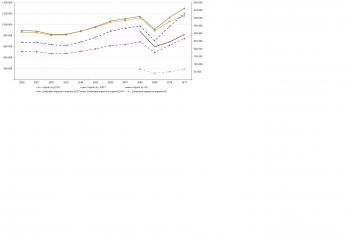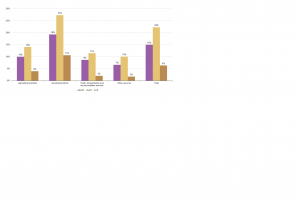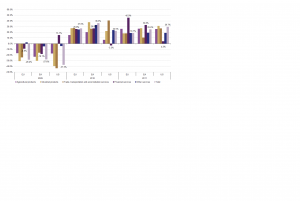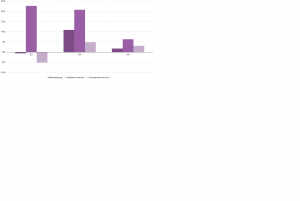Archive:Supply, use and input-output tables - EU-USA comparison
- Data from years 2010 and 2011.
In 2011, the intermediate imports content of exports was back to its 2008 level in the US (0 % average annual growth between 2008 and 2011) and even higher in the European Union (EU) (+2.7 % average annual growth) and the euro area (EA) (+7.3 %).

Main statistical findings
Between 2008 and 2011, exports from and imports into the European Union, the United States of America and the euro area decreased significantly in 2009. Exports decreased in the three economies by around 15 % and imports decreased by around 20 % in the EU and the euro area and by around 30 % in the US. In the two following years, exports and imports increased, bringing them back to, or even above, 2008 levels. In the EU and the EA, the intermediate imports embodied in exports [1] decreased by 30 % in 2009, then increased by 27 % in the EU and by 36 % in the euro area in 2010, and by 19 % in the EU and 25 % in the euro area the following year. In the US intermediate imports embodied in exports decreased by 37 % in 2009 but picked up again in 2010 (+22 %) and 2011 (+30 %).
In 2011 the intermediate imports embodied in exports returned to their 2008 levels in the US. They exceeded their 2008 levels by 8 % in the EU and by 24 % in the euro area (See figure 1).
In 2011 6 % of US export value originated in foreign locations; the ratio increases to 15 % for the EU and to 22 % for the euro area
Whatever the country, not all exports come from that country. Around 15 % of the EU’s exports came from outside the EU in 2011. This proportion is much higher for the euro area (22 %), reflecting how closely the two economies are related to the rest of the world in terms of trade. In the US the intermediate imports embodied in exports represent 6 % of total exports overall. This 6 % is dominated by industrial products 11 % of the exports for which come from outside the US. Intermediate industrial imports embodied in exports represent 19 % of total exports in the EU and 27 % of them in the euro area. For other products and services, over 10 % of euro area exports originate in foreign locations. This fluctuates between 7 % and 10 % for the EU (See figure 2).

Intermediate imports of financial services embodied in exports have changed differently from the total imports embodied in exports after the economic crisis of 2008
In the EU, the financial services imports embodied in exports decreased much less than the total embodied imports right after the 2008 economic crisis, with a -9 % decrease in 2009 compared with a -38 % decrease overall. From 2009 to 2010 the 26 % increase in financial services imports embodied in exports was comparable to the overall increase of all imports embodied in exports. But in 2011 financial services imports embodied in exports increased by 45 %, bringing their 2011 level to 1.7 times their 2008 level. The increase in financial services exports from outside the euro area followed the same pattern as in the EU, but they decreased more sharply by 18 % in 2009. They then increased as much as in the EU (26 %) in 2010 and less so in 2011 (33 %). There were more financial services imports embodied in exports in the US in 2009, 2010 and 2011 compared to 2008. There was a slight negative increase of 3.2 % in 2010 compared to 2009, but on average from 2008 to 2011 there was an annual 5 % increase in the financial services imports embodied in exports (See figure 3).

Downstream and upstream services contribute a lot to the manufacturing industry in the EU, the euro area and the US. They contribute to more than one third of EU and euro area exports and to more than half of US exports.
Services defined as upstream from manufacturing, involved before production and representing inputs into production, are financial services, real estate services and professional and technical services. Downstream, post-production services are wholesale trade services, transportation and storage services. Downstream and upstream services amounted to 7 % each of the costs for each unit of manufacturing output in the US in 2011; this increases to 10 % each for the EU and the euro area. Exports in the three economies are dominated by manufactured products. In 2011, 63 % of EU exports, 70 % of euro area exports and 52 % of US exports were manufactured goods. The proportion of downstream and upstream services exports was about the same in the three economies in 2011. Of EU exports, 18 % are downstream services exports. Of euro area exports, 14 % are downstream services exports and of US exports, 22 % are downstream services exports. Of EU exports, 19 % are upstream services exports. This is the case for 15 % of euro area exports and 25 % of US exports (See figure 4).

The services industry was the major employer in 2011
In terms of employment, in 2011 the EU and euro area economies were dominated by downstream services, with trade, transportation and accommodation services providing 43 % of total employment, followed by upstream services that provided 32 % of total employment and manufacturers that provided 25 % of total employment. In the US, manufacturers still provided the greatest proportion of total employment (37 %); but the services industry as a whole provided 63 % of total employment. Upstream services, with 35 % of total employment, outstrip downstream services with 28 %. But over the 2008–11 period, the fall in employment in the manufacturing industry has accentuated the fall in the level of total employment. Employment in the manufacturing industry in the EU decreased by 9 % and by 8 % in the manufacturing industry in the euro area. Total employment decreased by 2 %. In the US total employment decreased by 4 %. Employment in the manufacturing industry decreased by 6 % between 2008 and 2011. Upstream services employment increased in the EU and the euro area (with a 1 % overall increase for each zone during the period). In the US upstream services employment decreased by 4 % over the period compared to -5 % for total employment (See Table 1).

Between 2008 and 2011, the increase in employment embodied in exports was the result of the increase in employment in upstream services: +23 % in the EU, +21 % in the euro area and +6 % in the US
Direct and indirect services employment embodied in exports made up around 40 % of total export-related employment in the EU and the US in 2011. In 2011 EU exports supported 30 million jobs and US exports 11.1 million jobs. Of these, at least 7.5 million jobs in the EU were in upstream services such as finance, information and professional services and another 3.4 million were in wholesale trade, transportation and accommodation services (downstream services). More than 1.8 million US jobs were created through exports in upstream services while nearly 2 million jobs were in downstream services. Manufacturing remains the sector with the most export-related jobs: 60 % in the EU and 66 % in the US. But over the last few years (2008 to 2011) the increase in employment embodied in exports was lower for manufactured products exported than for upstream services exported. In the EU employment embodied in manufactured exports decreased slightly by 1 %. At the same time employment embodied in upstream services exports (financial services, professional and technical services, information services) increased by 23 % from 2008 to 2011, equivalent to an average annual increase of 7 %. Employment in downstream services exports is still lagging behind, with a decrease of 5 % over the period, but it is already catching up with its 2007 pre-crisis level. The euro area has been more dynamic in terms of employment embodied in exports. It increased greatly in all three sectors from 2008 to 2011: +11 % of employment embodied in manufactured exports, +21 % of employment embodied in upstream services exports and +5 % of employment embodied in downstream services exports. In the US exports of upstream services are contributing the most to the increase in employment, with +6 % over the 2008–11 period. This is followed by employment embodied in downstream services with +3 % and employment embodied in manufactured exports with +2 % (See figures 5 and 6).


Data sources and availability
According to a standard input-output technique, the European input-output tables were used to calculate the results of applying the Leontief quantity model to imports and employment. First, a domestic input coefficient matrix (A) was calculated for each homogenous branch of activity, showing the direct input requirements for the production of one unit of output. Then the Leontief inverse matrix (the inverse of I — A, being I, the identity matrix) was computed to obtain the matrix of output multipliers. Next, the Leontief inverse matrix was post-multiplied by a column vector of exports to calculate the total output embodied in those exports. Finally, output coefficients of imports and employment pre-multiplied the above embodied output values to obtain the imports embodied in exports (or imports content of exports) and the employment embodied in exports.
- Embodied import in exports or imports content of exports: imports realised by firms directly engaged in export activities (direct effects), including imports realised by upstream industries for the supply of the necessary inputs (indirect effects);
- Embodied employment in exports: number of persons employed by firms directly engaged in export activities (direct effects), including those employed by upstream industries for the supply of the necessary inputs (indirect effects).
In 2013, Eurostat compiled for the first time the supply and use tables for the United States using the new NACE Rev 2 classification, based on ISIC 4 and CPA 2008. The latest US ‘make’ and ‘use’ tables for 2010 and 2011 are available on the Bureau of Economic Analysis website. In December 2013, the Bureau of Economic Analyses (BEA), has published the revised make and use tables based on the new benchmark tables of the year 2007. The compilation of US tables is taking into account the revised tables. The ‘make’ matrix was compiled after redefinitions of data from the industry input-output (I-O) accounts. Like the ‘make’ table, the US ‘use’ table shows producer prices, while the European consolidated tables are in basic prices. Eurostat uses producer prices for the US table and basic prices for the EU table.
Context
The data are collected from the European System of National and Regional Accounts (ESA 1995) transmission programme. EU Member States transmit supply and use tables (SUTs) to Eurostat annually and input-output tables (IOTs) every five years up to 36 months after the end of the reference period. Consolidated European tables for the year 2010 are based on transmitted data from Member States (Eurostat was missing data only for a few Member States) For the year 2011, as the transmission deadline for Member States is end of 2014, the national supply and use tables have been estimated using a projection method (the Euro method) defined in the Eurostat Manual of Supply, Use and Input-Output tables.
The SUTs give detailed information on production processes, interdependencies in production, the use of goods and services, and income generated in production. They form the basis for symmetrical input-output tables, which are produced by applying certain assumptions to the relationship between outputs and inputs and are used by policy-makers for input-output analysis.
Environmentally extended input-output tables (EE IOTs), an extension in Eurostat, represent another powerful analytical instrument to inform policy.
Eurostat has compiled consolidated European tables for the EU-27 and the EA since September 2011. Data for years 2008 to 2011 are now available.
See also
- Building the System of National Accounts - supply and use tables (chapter of online publication Building the System of National Accounts)
- National accounts and GDP
- Supply and use tables - input-output analysis (background article)
Further Eurostat information
Publications
- In 2009, industrial products represent 28 % of the EU total output and 22 % in the US - Statistics in focus 24/2013
- European exports 2000-2007: direct and indirect effects on employment and labour income in the EU 27 and euro area - Statistics in focus 36/2012
- CO2 emissions induced by EU's final use of products are estimated to be 9 tonnes per capita - Statistics in focus 22/2011
Database
- Supply, use and Input-output tables (naio)
- Supply, use and Input-output tables - EU aggregates (naio_agg)
Dedicated section
Methodology / Metadata
- ESA 95 Supply Use and Input-output tables' methodology
- Eurostat Manual of Supply, Use and Input-Output Tables
- Compilation of USA SUIOT in the European classification - years 2008 to 2011
- Methodological information on the compilation of the US supply and use tables in European classications, September 2013
- Methodological information on the consolidated European tables for years 2008 and 2009
- Technical Documentation eeSUIOT project
Other information
External links
Notes
- ↑ It takes domestically made intermediate goods as well as imported intermediates to produce exports; the links between sectors need to be considered. Domestically made intermediate goods in turn require intermediate imports. When calculating the foreign content of exports, second-stage imports need to be added to the imports directly embodied in the exports. Other domestically made intermediates may also be needed to produce domestically made intermediates. These other domestically made intermediates may require imported inputs. And so on and so on. All the stages are added together to get to the direct plus indirect imports embodied in exports.
[[Category:<National_accounts_(incl._GDP)>|Consolidated supply, use and input-output tables]] [[<Category:Statistical article>|Consolidated supply, use and input-output tables]]